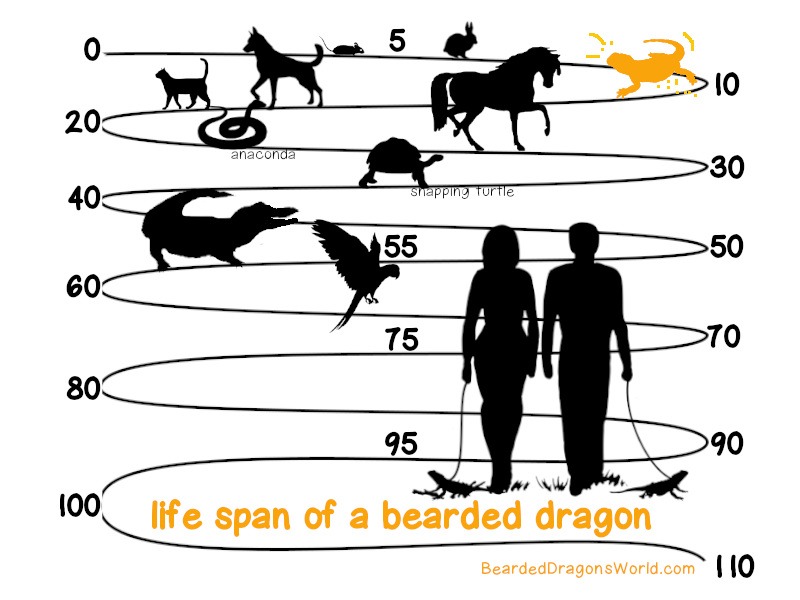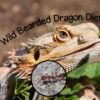Bearded dragons life expectancy differs with factors like environment, diet, veterinary care, and genetics playing a significant role in determining their longevity.

Jump To…
How Long Do Bearded Dragons Live For?
The bearded dragons life expectancy is somewhere between 4 to 12 years but can go as high as almost 20 years in the right conditions. Every source varies on the lifespan of bearded dragons but generally all specify ages within the 4-12 years. This is relatively shorter compared to some other reptile species. There are also some cases of bearded dragons living up to and even past 14 years. According to the Guinness Book of World Records, one bearded dragon in the UK named Sebastian lived for 18 years and 237 days before dying in January 2016.
The bearded dragons life expectancy is an important consideration when it comes giving bearded dragons to children for pets. Who will be looking after the pet if your children will move on to a college or out of home in 5 or 10 years?
It is nearly impossible to determine the exact lifespan of bearded dragons in the wild but there are guesstimates out there which are less than that of our pets. Of course many will die from predators before old age since they slow down as life goes on.
In captivity, bearded dragons lifespan varies based on factors such as diet, habitat conditions, and healthcare. Providing a balanced diet, maintaining optimal habitat conditions, and regular health monitoring are essential for supporting their health and longevity.
Conditions to Aid a Bearded Dragons Life Expectancy
Compared to many other exotics, bearded dragons are easy to care for. Unfortunately this gives them the title of being great pets for beginners. Their needs are not always recognised or catered for and this can bring about stress, ill health to early death.
75% of pet reptiles in the UK die within their first year (Fry, 2015). This is not just an issue in the UK, it is worldwide. The quality of care directly impacts their life. The good news is that if well looked after, then bearded dragons can have a lifespan of 10+ years.
Here are 5 ways to increase the bearded dragons life expectancy:
- Impact of Diet on the Bearded Dragons Life Expectancy
Bearded dragons are omnivorous and in the wild will eat a wide variety of vegetation including leaves and flowers as well as insects. When keeping a bearded dragon as a pet, it is important to approximate this diet by giving it a range of invertebrates and leafy greens. Supplements are also important, mainly calcium and vitamin powder. - Good Husbandry Practices
The bearded dragons life expectancy is directly impacted by the quality of husbandry practices from cleanliness to feeding practices. - Providing a Natural Habitat
A well-designed habitat that simulates a bearded dragon’s natural environment is key to their wellbeing. Other essentials of the habitat are using the best substrates, lighting, and providing space. - Healthcare and Disease Prevention Aids in a Bearded Dragons Life Expectancy
A proactive approach to healthcare is vital. Awareness and early intervention with conditions like metabolic bone disease, impaction, and respiratory infections prolong life expectancy. Regular veterinary check-ups and immediate attention to behavioral changes are effective preventive measures. - Impact of Brumation on Bearded Dragons Life Expectancy
The winter dormancy period called brumation can affect your bearded dragon’s health and maybe lifespan. There has been some speculation amongst vets that brumation could elongate a bearded dragons life expectancy. - Scheduled Veterinary Care
Regular veterinary check-ups are indispensable for extending the lifespan of a bearded dragon. To ensure your bearded dragon lives a long life, be aware of potential health issues and how to prevent and treat them. Common health issues include metabolic bone disease (MBD), atadenovirus, impaction and parasites. Many diseases and issues are preventable simply by providing a balanced diet and proper habitat including adequate heat and lighting. Visit a veterinarian familiar with reptiles at least annually prior to brumation. For new bearded dragons, VCA Hospitals recommend you visit within 48 hours of purchase for an examination to check for physical abnormalities, signs of dehydration and weight loss, and parasites (Axelson and Hess, 2016). - Hydrating Bearded Dragons
Hydration for pet bearded dragons can be an issue and continual mild dehydration is a recipe for diseases which take years to become evident. They don’t need much as they are extraordinarily efficient at using water, but they do need some daily. Water can be provided to bearded dragons in many ways including misting, water bowls and bathing.
Bearded Dragons Life Expectancy: Understanding Reptile Senescence
Understanding reptile senescence (the process of ageing) can offer valuable insights into the care and expectations for pets. Recent studies by Hoekstra et all (2019) in the field of comparative ageing biology in reptiles reveal that, like other animals, reptiles exhibit increased mortality and potential reproductive declines as they age. However, the rate and manner of ageing can vary significantly across different reptile species.
Bearded dragons, in particular, are among the reptiles that have been studied, and while comprehensive data on their specific ageing patterns are limited, insights from broader reptile research can be applied. For instance, reptiles, including bearded dragons, tend to have a diverse diet that evolves from being insect-heavy as hatchlings to more plant-based as adults. This dietary shift reflects their adaptive nature and the need for a varied diet to meet their nutritional needs throughout their life stages.
Moreover, reptiles share many ageing mechanisms with mammals and birds, such as DNA damage and repair, stress response adaptations, and metabolic processes. Understanding these mechanisms can help us to appreciate the complexity of reptile ageing and the importance of providing an environment that supports a bearded dragons health and longevity.
For bearded dragon owners, this means focusing on proper diet, habitat conditions, and health monitoring to support a potentially long lifespan. Ensuring a diverse and nutritionally balanced diet, maintaining optimal habitat temperatures and lighting, and regular veterinary check-ups can contribute to a healthy ageing process for bearded dragons.
Senescence in reptiles manifests in three primary forms as follows:
- Gradual Senescence:
- Observed in: Most Squamates (including bearded dragons, lizards, and snakes)
- Characteristics:
- Increased mortality rate with age
- Decreased reproductive capacity over time
- General physical deterioration
- This form is similar to the ageing process seen in birds and mammals.
- Negligible Senescence:
- Observed in: Chelonians (turtles and tortoises) and Crocodilians
- Characteristics:
- Continuous growth throughout life
- Senescence is either very slow or not noticeable
- Sustained reproductive capacity and low mortality rate even in older age
- Rapid Senescence:
- Observed in: A few small reptile species, not applicable to bearded dragons
- Characteristics:
- Rapid ageing and death shortly after sexual maturity and mating
- Similar to the life cycle observed in Pacific salmon and some small marsupials
- Best documented in Buettner’s mabuya (a small African skink)
Bearded dragons, as part of the Squamate order, generally experience gradual senescence after reaching maturity, akin to birds and mammals. This means that, compared to other reptiles like Chelonians and Crocodilians that exhibit negligible senescence, bearded dragons do not live as long. However, they do not age as quickly as the few reptile species that undergo rapid senescence.
Age estimation in reptiles, crucial for understanding and managing their geriatric care, remains challenging due to their often lengthy lifespans and subtle ageing indicators. Techniques like sclerochronology, which involves analyzing growth marks in epidermal scutes, offer some insights but are less precise and can be influenced by factors like diet and environment in captivity.
Geriatric care for reptiles, including bearded dragons, emphasizes the importance of regular veterinary examinations to manage age-related health issues effectively. Conditions associated with ageing in reptiles can often be subtle and insidious, necessitating vigilant observation by caregivers and routine health assessments.
Conclusion
In summary, a bearded dragons life expectancy is anywhere from a few to 14 years. What makes the difference is primarily the quality of care they receive.
While reptiles, including bearded dragons, share common ageing processes with other animals, their unique adaptations and lifestyles require specific care considerations. By understanding the basics of reptile senescence and applying this knowledge to a reptiles care, bearded dragons will have the support they need to lead a long, healthy life.
Bearded dragons have a third eye known as the parietal eye. This unique feature helps them sense predators and may play a role in their health and longevity.
References
- Axelson, R. DVM, Hess, L. DVM. (2016) Bearded Dragons – Owning.
- Australian Museum. (2019) Central Bearded Dragon.
- Fry, B. (2015) Venomous Reptiles and Their Toxins: Evolution, Pathophysiology, and Biodiscovery.
- Hoekstra, L. A., Schwartz, T. S., Sparkman, A. M., Miller, D. A. W., & Bronikowski, A. M. (2019). The untapped potential of reptile biodiversity for understanding how and why animals age. Functional Ecology, 34(1), 38–54.
- Paré, J. A., & Lentini, A. M. (2010). Reptile Geriatrics. Veterinary Clinics of North America: Exotic Animal Practice, 13(1), 15–25.
- Schabacker, S. Bearded Dragon. National Geographic. Accessed February 2020.
- Guinness World Records. Oldest Bearded Dragon Ever. Accessed February 2020.





